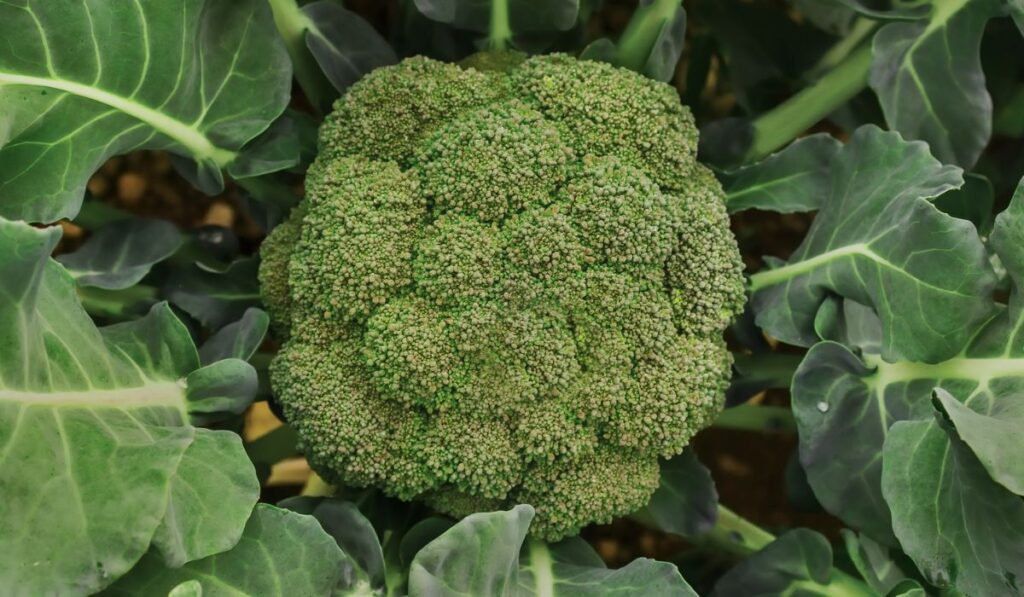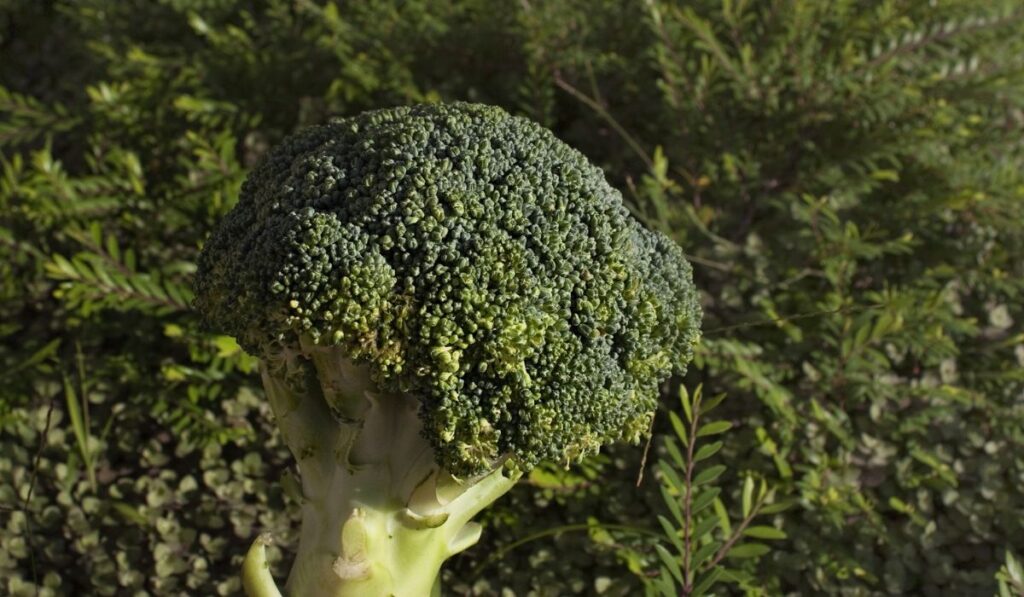If you’re new to gardening, you might think planting broccoli is challenging; however, this nutritious crop is quite easy to grow. To grow broccoli successfully, you need to learn when to plant it.
In most regions, you can plant broccoli during spring and early fall. Broccoli is a cool-season crop that stops producing buds when exposed to high temperatures for too long. A broccoli seedling is usually planted indoors before being transplanted outdoors into a plant bed to mature.
There are more crucial steps involved in growing this crop, so let’s turn our attention to everything you need to know about how to pull off growing this amazingly healthy food at home.
How Late in the Year Can You Plant Broccoli?

You can plant broccoli seeds (on Amazon) earlier from May to April and late during September. However, if you wish to grow broccoli in spring, start indoors five to six weeks before the last spring frost in your location.
For planting broccoli during fall, sow the seeds about 10 to 14 weeks before the first frost. Broccoli is a cool-season vegetable, meaning they don’t like high temperatures. That’s why it is essential to sow them indoors and wait until they mature until transplanting them outdoors.
When planting broccoli during spring, the main aim is to harvest them around early summer before the temperature gets too high. On the other hand, planting broccoli during September yields harvests during winter the following year.
How to Plant Broccoli
Planting broccoli usually involves two stages: planting indoors and transplanting later outdoors. Unfortunately, as discussed earlier, broccoli doesn’t grow well in high temperatures. So, growing these vegetables indoors can help them develop to withstand the harsh high temperatures outdoors.
When Planting Broccoli Indoors:
- Pick a good indoor location with plenty of sunlight for placing the seedling tray/planting pot. Finding a sunny spot is crucial because most standard indoor lights are inadequate for growing broccoli indoors.
- Buy or mix your seed starter soil. Make sure the mix is fertile and light.
- Fill up the seedling tray halfway with seed starter soil. Plant the seed about a quarter-inch deep, and maintain three inches of space between seedlings.
- Ensure the soil is slightly moist and compact to prevent the seeds from moving in the tray.
- Plant broccoli seedlings indoors five to six weeks before the last frost in spring and harden the seedlings for about four days. Hardening is the process of exposing transplants gradually to outdoor conditions.
- After planting the seeds for four to six weeks, transplant them into a garden. Check if the broccoli has four to five true leaves before transplanting them outdoors. Keep in mind that broccoli’s first two leaves aren’t true leaves.
When Planting Broccoli Outdoors:
- Plant transplants in holes deep enough to accommodate their roots.
- Ensure the plants are 10 to 20 inches apart on the plant bed.
- Make sure to space the rows of broccoli three feet apart. Spacing broccoli rows closely typically yield smaller main heads but more secondary heads.
We recommend growing broccoli on plant beds where you have not grown related crops—like cabbage, cauliflower, collards, kale, turnip, etc.—for four years.
Does Broccoli Need Full Sun?
Broccoli grows best in full sun. Full sun refers to a minimum of six hours of direct sunlight per day. It makes no difference whether the hours of daylight are during morning, midday, or afternoon as long as the broccoli receives the necessary exposure.
Growing this plant without enough sunlight can lead to bitter broccoli heads. While these crunchy greens require a lot of direct sunlight to thrive, broccoli heads can grow in partial shade.
Partial shade helps keep the plant from wilting in the summer heat. On the other hand, ensure you don’t expose the plant to indirect sunlight as it is harmful to broccoli heads.
How Deep Should Broccoli be Planted?
You should plant broccoli seeds about a quarter-inch deep into the soil and place the transplant deep enough to accommodate the growing roots. Planting the seedling a little deeper will allow the plant to become stronger and more capable of supporting the weight of the broccoli head when it grows.
How Far Apart to Plant Broccoli
If you’re planting seedlings indoors, maintain a three inches space between seedlings in the seedling tray. However, when you move the broccoli seedling to a plant bed outdoor, keep a 10 to 20-inch gap between each plant. Furthermore, ensure you space the rows of broccoli three feet apart.
How to Grow Broccoli
Broccoli grows best in temperatures ranging from 65°F to 70°F. Ensure you fertilize broccoli three weeks after transplanting it into the garden. For the best outcome, use a fertilizer with low nitrogen content.
Watering
Do not forget to water the plant regularly to maintain consistent soil moisture, especially during dry conditions. We recommend watering each plant with two inches of water every week. It is essential to avoid wetting young broccoli heads as this can promote rot.
Once you notice the growth of the first broccoli head, maintain a regular watering schedule to encourage the development of another. Install a net around your planting area to prevent pests like birds from feeding on your plant’s crown.
Mulching
Another vital activity to do is mulching. Mulching your broccoli has many benefits. It helps control the growth of weeds and reduces soil temperatures, creating a more favorable environment.
Is Broccoli Easy to Grow?
Broccoli is a nutritious crop that produces a tasty crop of blue/green heads. Even if you’re new to gardening, broccoli is one of the simplest cool-season crops to cultivate.
Broccoli requires low maintenance all through its growth cycle. This plant grows well as long as you plant it at the right time and do not expose the buds to high temperatures. You also need to ensure there are enough nutrients and moisture in the soil.
These plants prefer well-drained, fertile soil that is slightly acidic with a pH ranging from 6.0 to 6.8. Additionally, your planting area must be moist and rich in organic matter. The reason is that both pH and organic matter play a role in the availability of nutrients and essential micronutrients.
How Long Does it Take to Grow Broccoli?
Broccoli takes between 80 and 100 days to mature from seed to harvest. The exact time depends on the broccoli specie and your location. On the other hand, when you plant the broccoli seeds indoors and transplant them, the harvest time is usually 50 to 85 days after.
Does Broccoli Need a Lot of Water?
Broccoli requires a lot of water to grow properly. These veggies grow best when they’re being watered thoroughly but infrequently. Remember that your watering schedule needs to be flexible depending on the weather.
For instance, water the plant once a week when you notice temperatures are below 75°F. On the other hand, when temperatures are above 75°F, water the broccoli twice a week.
A quick tip, when watering broccoli, use a soaker hose for around 30 minutes. But overwatering these plants may result in the growth of fungal diseases or oxygen deficiency. So, push your finger into the soil to check the moisture level before you start watering.
Will Broccoli Regrow After Cutting?
Generally, broccoli produces several side shoots. These side shoots continue to grow after the main head has been harvested. These smaller heads allow you to harvest two or three crops from a single broccoli plant.
If you notice the main head of the plant is deep green with no yellow hues, you can harvest it. Harvesting when the plant is still deep green indicates that side shoots will continue forming after the main head has been cut.
However, if the main head begins yellowing, the plant won’t produce any side shoots. Therefore, after you harvest the broccoli heads and side shoots, pull out the plant and compost it. This step is crucial because it replenishes the soil with nutrients.
How to Harvest Broccoli

Plan broccoli planting so that harvest occurs during a cool season. To determine when broccoli is ready for harvest, gently tug the buds on the main head. If the buds feel tight, move on to another plant. But if the buds are loose, you can start harvesting.
It would be best to harvest broccoli with a sharp knife or shears. Cut the stems at an angle to prevent excess moisture, thereby deterring the growth of fungal diseases. After the first harvest, wait for two days before checking the plant for new buds to harvest.
The plant will continue producing side shoots with tiny buds until frost kills it. If you notice yellow flowers on some buds, remove them immediately, as they will stop the production of side shoots.
How to Store Broccoli
You should store broccoli in cold and moist storage at 35°-40°F and 95 percent relative humidity. However, finding these storage types may pose a challenge since refrigerators are not ideal for storing broccoli. Because while fridges are cold, they don’t provide the necessary moisture the plant needs to last for weeks.
However, a helpful trick would be to place the broccoli in a perforated plastic bag and put it in your fridge’s crisper drawer. And you can store broccoli in the refrigerator for about a week before it is inedible.
Blanched broccoli, however, can be frozen for up to a year. Lastly, if you wash your plants before storing them, ensure they are adequately dried to prevent rust.
Conclusion
There you have it! As you can see, planting broccoli is pretty straightforward and requires low maintenance. Now that you know how to grow broccoli wait till the appropriate season and try planting it in your garden.
Remember, you can plant broccoli twice a year: First, during May or April, and later around September. Ensure the plant gets plenty of water and sunlight, and don’t forget to cut the head at an angle to encourage the development of more side shoots.
If you follow these simple steps, planting broccoli will be a breeze.
